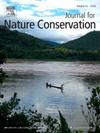Plant-litter-soil ecological stoichiometry and stoichiometric homeostasis of tree tissues under three desertified grassland restoration modes in northern China
IF 2.5
3区 环境科学与生态学
Q2 BIODIVERSITY CONSERVATION
引用次数: 0
Abstract
Afforestation is the primary strategy to address ecological degradation in northern China’s Horqin sandy region. This study utilized ecological stoichiometry as field study indicators and laboratory analysis to assess the afforestation strategies of three indigenous tree species to restore sandy grassland. The three restoration strategies were as follows: (1) grasslands were enclosed by a Populus × beijingensis shelterbelt (FG); (2) Pinus sylvestris var. mongolica was used for the afforestation of small, well-distributed grassland patches (MG); and (3) Ulmus pumila was used for the afforestation of small, well-distributed patches (UG). The results revealed FG, MG, and UG had significantly different C:N:P ratios as well as significant variations in the amounts of C, N, and P in the plants, litters, and soils. After more than 20 years of recovery, it was discovered that all three treatments had a substantial effect on the C:N, N:P, and C:P ratios of the soil in comparison to the CK. The N:P results in various tissues demonstrated that N-limited was the case with the FG, MG, and UG restorations. There was N and P homeostasis in the trees, particularly Populus × beijingensis whereas the species of afforestation and plant tissues had a major influence on the degree of homeostasis. FG was better suitable for the arid climate in this area, according to the ecological stoichiometry results of C, N, and P content and stoichiometric homeostasis. The research results can provide scientific basis for the ecological restoration and vegetation reconstruction of fragile ecological areas in Inner Mongolia, China.
北方3种沙化草地恢复模式下植物-凋落物-土壤生态化学计量学及树木组织化学计量动态平衡
植树造林是解决中国北部科尔沁沙区生态退化的首要策略。本研究采用生态化学计量学作为野外研究指标和室内分析相结合的方法,对三种乡土树种在沙质草地恢复中的造林策略进行了评价。三种恢复策略分别是:(1)以北京杨树林(FG)为围护层;(2)在小块、分布均匀的草地斑块(MG)中利用蒙古松造林;(3)在小块、均匀分布的斑块(UG)上利用矮榆造林。结果表明,FG、MG和UG的C:N:P比值存在显著差异,植物、凋落物和土壤中C、N、P含量也存在显著差异。经过20多年的恢复,发现与对照相比,三种处理对土壤的C:N、N:P和C:P比率都有实质性的影响。不同组织的N:P结果表明,FG、MG和UG修复体的N限制。以北京杨树为代表的北京杨树体内存在氮、磷稳态,而造林种类和植物组织对其稳态影响较大。从C、N、P含量的生态化学计量结果和化学计量动态平衡来看,FG更适合该地区的干旱气候。研究结果可为内蒙古脆弱生态区的生态恢复和植被重建提供科学依据。
本文章由计算机程序翻译,如有差异,请以英文原文为准。
求助全文
约1分钟内获得全文
求助全文
来源期刊

Journal for Nature Conservation
环境科学-生态学
CiteScore
3.70
自引率
5.00%
发文量
151
审稿时长
7.9 weeks
期刊介绍:
The Journal for Nature Conservation addresses concepts, methods and techniques for nature conservation. This international and interdisciplinary journal encourages collaboration between scientists and practitioners, including the integration of biodiversity issues with social and economic concepts. Therefore, conceptual, technical and methodological papers, as well as reviews, research papers, and short communications are welcomed from a wide range of disciplines, including theoretical ecology, landscape ecology, restoration ecology, ecological modelling, and others, provided that there is a clear connection and immediate relevance to nature conservation.
Manuscripts without any immediate conservation context, such as inventories, distribution modelling, genetic studies, animal behaviour, plant physiology, will not be considered for this journal; though such data may be useful for conservationists and managers in the future, this is outside of the current scope of the journal.
 求助内容:
求助内容: 应助结果提醒方式:
应助结果提醒方式:


